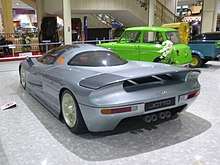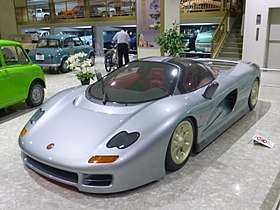Jiotto Caspita
The Jiotto Caspita is a prototype mid-engine sports car designed and manufactured by Dome in 1989. The car was billed as the "F1 on the Road." The original design of the car was done by Kunihisa Ito, who was the vice-president and chief designer of Jiotto Design Incorporated.

| DOME Jiotto Caspita | |
|---|---|
 1989 Jiotto Caspita (Mk I) on display | |
| Overview | |
| Manufacturer | DOME Co. Ltd. |
| Production | 1989–1990 |
| Model years | 1989–1993 |
| Assembly | Japan: Maihara |
| Designer | Jiotto Design Studio under Minoru Hayashi |
| Body and chassis | |
| Class | Sports car (S) |
| Body style | 2-door coupé |
| Layout | Rear mid-engine, rear-wheel drive |
| Doors | Gullwing |
| Powertrain | |
| Engine |
|
| Transmission | 6-speed Wiesmann manual |
| Dimensions | |
| Wheelbase | 2,700 mm (106.3 in) |
| Length | 4,534 mm (178.5 in) 4,595 mm (180.9 in) (Mk II) |
| Width | 1,996 mm (78.6 in) |
| Height | 1,135 mm (44.7 in) |
| Curb weight | 2,425 lb (1,100 kg) 2,734 lb (1,240 kg) (Mk II) |
The car was the brainchild of the president of Wacoal Corp Yoshikata Tsukamoto and the president of DOME Minoru Hayashi. A joint venture between the two companies was formed in July 1988 by the name of Jiotto Inc (60% held by Wacoal and 40% held by DOME) to design and build the car. The mechanical work was entrusted to Dome while a newly incorporated studio was assigned to design the car.
The design emphasis was Group C race cars and keeping that in mind, the car had a sleek and aerodynamic body design. Design mockups of 1/5 scale were made for wind tunnel testing. Later, full size models were made and tested at DOME's own wind tunnel as well as JARI’s (Japan Automobile Research Institute) wind tunnel for aerodynamic refinement. Jiotto Design selected three designs out of initially proposed 200 for final development. Out of the three, a proposal having an integrated rear wing and large side air intakes was fully developed.
The interior focused on the driver and was spartan in nature. It was trimmed in red and black leather. A tachometer with white digits was mounted centrally behind a lightweight twin-spoke steering wheel while all necessary switches were combined into the central console as well as the dashboard; an electronic LED speedometer and fuel gauge were placed on the left along with a small LCD display which displayed fuel and oil pressure. The interior lacked air conditioning, cruise control and other driver amenities.
The car had a bonded aluminium and carbon fibre monocoque chassis made by Mitsubishi Rayon Co. The construction technique involved sandwiching aluminium between layers of carbon fibre and then baking them to create a rigid structure. The process was repeated 15 times and it took 2 months to make a chassis. This technique resulted in a weight of 2,425 lb (1,100 kg).
The car was named Caspita which means "good heavens!" in Italian, an expression of an unexpected surprise. It was displayed at the 28th Tokyo Motor Show. The Caspita employed advanced technology of the time, such as an electronically retractable rear spoiler and an electronically controlled adjustable suspension system which raised the car by 2.3 in (58.4 mm).[1][2]
The first car was powered by a Motori Moderni Flat-twelve engine, a detuned Formula One engine rated at 450 hp (336 kW; 456 PS) and 363 N⋅m (268 lb⋅ft) originally built for Subaru, and then in 1990 a second concept was built with a Judd GV V10 engine, new twin circular taillights, and more traditionally styled side mirrors. The reason being that Subaru took the engine to use in its Formula-one car for the 1990 season. Seeing the disappointing results, Subaru pulled the plug on the project leaving Jiotto without an engine supplier.[3]
Both engines were longitudinally mounted, and powered through a 6-speed gearbox built by Wiesmann. The project would die out in 1993 due to the global recession which meant lack of demand for sports cars.[4] With the Judd engine, the Caspita is capable of 577 hp (430 kW) at 10,750 rpm and 384 N⋅m (283 lb⋅ft) of torque at 10,500 rpm. This, along with a curb weight of 2,734 lb (1,240 kg), gives the Caspita a 0-60 mph (97 km/h) acceleration time of approximately 4.7 seconds and a top speed of 199 mph (320 km/h).[5]
Seeing the positive rception, a limited production run of 30 units was considered. But due to the soured deal with Subaru and due to the lack in demand for sports cars, the production plans never came to fruition.
The Mk.I Caspita is currently on display at the Motorcar Museum of Japan, whilst the Mk. II is still in the possession of Dome and sits in their museum below the wind tunnel at their headquarters.
Specifications (1989 Mk I Caspita)
Dimensions
- Wheelbase: 2,700 mm (106.3 in)
- Track - front: 1,630 mm (64.2 in)
- Track - rear: 1,600 mm (63.0 in)
- Length: 4,534 mm (178.5 in)
- Width: 1,996 mm (78.6 in)
- Height: 1,135 mm (44.7 in)
- Length-to-wheelbase ratio: 1.68
- Kerb weight: 1,100 kg (2,425 lb)
- Weight distribution: 40/60
- Fuel capacity: 100 L (22.0 imp gal; 26.4 US gal)
Engine
- Manufacturer: Motori Moderni
- Type: DOHC flat-12
- Total valves: 60 (5 per cylinder)
- Main bearings: Standard
- Bore x stroke: 84.00 mm (3.3 in) x 52.60 mm (2.1 in)
- Bore x stroke ratio: 1.6
- Displacement: 3497 cc (213 in³)
- Unitary capacity: 291 cc/cylinder
- Fuel system: EFi
- Aspiration: Natural
- Compressor type: N/A
- Intercooler: None
- Catalytic converter: Standard
- Max. output: 456 PS (335 kW; 450 hp) @ 10,000 rpm
- Max. torque: 362 N⋅m (267 lb⋅ft) (36.9 kgf·m) @ 6,000 rpm
- Coolant water: Standard
- Specific output: 128.7 bhp (96 kW; 130 PS) per litre (2.11 bhp/in³, 96.0 kW/L)
- Specific torque: 103.5 N·m/L
Performance
- 0–62 mph (100 km/h): 4.7s
- Top speed: 199 mph (320 km/h)
- Power-to-weight ratio: 409 bhp per metric ton (305 kW/t)
Other
- Engine layout: Mid-engine
- Alignment: Longitudinal
- Steering type: Rack and pinion
- Suspension: independent double-wishbone coil-spring with anti-roll bars (Front and rear)
- Wheels: 9JJ x 17 (F), 13JJ x 17 (R)
- Tyres: 245/40 ZR 17 (F), 335/35 ZR 17 (R)
- Brakes: ventilated discs
- Brake size: 332 mm
- Transmission: 6-speed
- Drivetrain: Rear-wheel drive
- Top-gear ratio: 1.00
- Final drive ratio: 3.75
Specifications (1990 Mk II Caspita)
Dimensions
- Wheelbase: 2,700 mm (106.3 in)
- Track - front: 1,630 mm (64.2 in)
- Track - rear: 1,600 mm (63.0 in)
- Length: 4,595 mm (180.9 in)
- Width: 1,996 mm (78.6 in)
- Height: 1,135 mm (44.7 in)
- Length-to-wheelbase ratio: 1.7
- Kerb weight: 2,734 lb (1,240 kg)
- Weight distribution: 40/60
- Fuel capacity: 100 L (22.0 imp gal; 26.4 US gal)
Engine
- Manufacturer: Judd
- Type: 72-degree DOHC V10
- Total valves: 40 (4 per cylinder)
- Main bearings: Standard
- Bore x stroke: 92.00 mm (3.6 in) x 52.60 mm (2.1 in)
- Bore x stroke ratio: 1.75
- Displacement: 3497 cc (213 in³)
- Unitary capacity: 349.7 cc/cylinder
- Fuel system: EFi
- Aspiration: Natural
- Compressor type: N/A
- Intercooler: None
- Catalytic converter: Standard
- Max. output: 585 PS (430 kW; 577 hp) @ 10,750 rpm
- Max. torque: 385 N⋅m (284 lb⋅ft) (36.9 kgf·m) @ 10,500 rpm
- Coolant water: Standard
- Specific output: 165 bhp (123 kW; 167 PS) per litre (2.7 bhp/in³, 96.0 kW/L)
- Specific torque: 110.09 N·m/L
Performance
- 0–62 mph (100 km/h): 4.7s
- Top speed: 199 mph (320 km/h)
- Power-to-weight ratio: 409 bhp per metric ton (305 kW/t)
Other
- Engine layout: Mid-engine
- Alignment: Longitudinal
- Steering type: Rack and pinion
- Suspension: independent double-wishbone coil-spring with anti-roll bars (Front and rear)
- Wheels: 9JJ x 17 (F), 13JJ x 17 (R)
- Tyres: 245/40 ZR 17 (F), 335/35 ZR 17 (R)
- Brakes: ventilated discs
- Brake size: 332 mm
- Transmission: 6-speed
- Drivetrain: Rear-wheel drive
- Top-gear ratio: 1.00
- Final drive ratio: 3.75
See also
- Yamaha OX99-11
- McLaren F1
- Cizeta-Moroder V16T
- Bugatti EB110
References
- Padeanu, Adrian. "Concept We Forgot: Jiotto Caspita". Motor1.com. Retrieved 2020-05-22.
- "[EXCLUSIVE] - Jiotto Caspita - FULL STORY". ACI. Retrieved 2020-05-22.
- Orlove, Raphael (June 27, 2017). "The Jiotto Caspita Was One Of The Greatest Supercars That Never Was". Jalopnik. Retrieved May 22, 2020.
- "Jiotto Caspita, Japan's original supercar". Motor Authority. Retrieved 2020-05-22.
- "[EXCLUSIVE] - Jiotto Caspita - FULL STORY". ACI. Retrieved 2020-05-22.